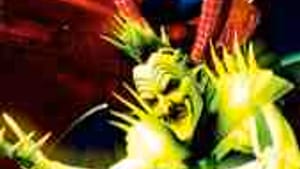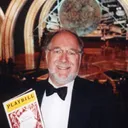Stay in the Loop
BSR publishes on a weekly schedule, with an email newsletter every Wednesday and Thursday morning. There’s no paywall, and subscribing is always free.
Not just another action hero
"Spider-Man' on Broadway (2nd review)

Spider-Man: Turn Off the Dark is a good show. There, I've said what seems to be the politically incorrect position these days, but it's true.
Make no mistake: Spider-Man isn't Ibsen or Chekhov. Don't expect this show to probe the human condition or society's underlying problems. It's a comic-book adventure story that adds the frisson of live action.
The result has mass appeal, with particular attraction for the adolescents who cram movie theaters every weekend, not to mention us former adolescents who read the Spider-Man comic books growing up.
The unrealized ambitions of writer-director Julie Taymor or the changes implemented since she was fired are irrelevant. I take the musical for what it is here and now.
Spider-Man's action hero, Peter Parker, is more interesting by far than Superman (who figured in a 1966 Broadway show, It's a Bird, It's a Plane) because the geeky Peter is vulnerable. Clark Kent was just a nebbishy disguise for a superhuman, whereas Parker is real and Spidey is his disguise. Parker harbors doubts about his priorities: Is his personal life more important than his duty to the public? This conflict, and his romance with Mary Jane Watson, add some dimension to the show.
Reach up and touch him
Primarily, Spider-Man: Turn Off the Dark is an action show about a hero confronting threatening enemies, and what everyone wants to see is Spidey climbing walls, swinging from building to building and tossing his spider webs over his opponents. This he does spectacularly.
When he swings over the tenth row— so low that if you reached up you could touch him— you've got to be thrilled. Nor are the patrons in balcony seats cheated: Spider-Man's leaps begin or end in one of galleries. Best seat of all is eighth-row orchestra on the right-side aisle, because Spidey, at one point, lands and pauses briefly to high-five the lucky man or woman seated there.
When Spider-Man chases the Green Goblin through the air and wrestles him just over our heads (and just below the balcony-dwellers) you'd have to be a misanthrope not to feel any thrill. The lead actors perform their own stunts, joined by nine additional Spideys, who demonstrate how Spider-Man becomes omnipresent as a New York crime-fighter, responding to multiple concurrent emergencies.
Brantley's complaint
Ben Brantley in the New York Times complained that Spider-Man's "potential magic was undercut" by the fact that wires are visible. Come on! Even six-year-olds in the audience know that Spider-Man isn't really flying. What the kids want to see is how astonishing the make-believe can be. And here's the answer: It's more exciting than anything you'll see in a circus or a Cirque du Soleil production, let alone any previous Broadway show.
Set designer George Tsypin, abetted by projection designer Kyle Cooper, created colorful visuals, sticking with the cartoony theme. Interjections appear in hyperbolic print, like "Ka-boom," reminding us of the old Batman series on TV. Cardboard pop-ups represent Peter's home, school lab and the newspaper office where he gets a job as photographer.
When Spider-Man takes to the skies, the stage presents effective representations of the Chrysler Building and other Manhattan landmarks. Near the end of the show comes a coup de théâtre, as audience members seem to fly over the top of the Chrysler spire, its perspective progressively changing as we see cars move on the street far below. Meanwhile, Spider-Man and the Green Goblin catapult through the space in front of the stage.
Not your usual rock score
Reeve Carney (in his theater debut) is appealing as Peter/Spidey, and Jennifer Damiano (from Next to Normal) is winning as his girlfriend. Patrick Page mops up the stage with a comic, over-the-top rendering of the villain, while Michael Mulheren plays the blustery newspaper editor.
Because the music is written by Bono and the Edge, of the group U2, theatergoers may have expected a hard-driving rock score like some other recent shows (Spring Awakening or American Idiot, for example). Instead, the music functions more like a movie score, underscoring much of the script.
The song, "If the World Should End," is a quiet ballad sung by Damiano. Its accompaniment is a surprisingly intimate guitar solo with cello obbligato. Other good songs are the heartfelt "Rise Above," the powerful "Boy Falls From the Sky," the ethereal and introspective "Turn Off the Dark" and the catchy "Bouncing Off the Walls."♦
To read another review by Carol Rocamora, click here.
To read a response, click here.
Make no mistake: Spider-Man isn't Ibsen or Chekhov. Don't expect this show to probe the human condition or society's underlying problems. It's a comic-book adventure story that adds the frisson of live action.
The result has mass appeal, with particular attraction for the adolescents who cram movie theaters every weekend, not to mention us former adolescents who read the Spider-Man comic books growing up.
The unrealized ambitions of writer-director Julie Taymor or the changes implemented since she was fired are irrelevant. I take the musical for what it is here and now.
Spider-Man's action hero, Peter Parker, is more interesting by far than Superman (who figured in a 1966 Broadway show, It's a Bird, It's a Plane) because the geeky Peter is vulnerable. Clark Kent was just a nebbishy disguise for a superhuman, whereas Parker is real and Spidey is his disguise. Parker harbors doubts about his priorities: Is his personal life more important than his duty to the public? This conflict, and his romance with Mary Jane Watson, add some dimension to the show.
Reach up and touch him
Primarily, Spider-Man: Turn Off the Dark is an action show about a hero confronting threatening enemies, and what everyone wants to see is Spidey climbing walls, swinging from building to building and tossing his spider webs over his opponents. This he does spectacularly.
When he swings over the tenth row— so low that if you reached up you could touch him— you've got to be thrilled. Nor are the patrons in balcony seats cheated: Spider-Man's leaps begin or end in one of galleries. Best seat of all is eighth-row orchestra on the right-side aisle, because Spidey, at one point, lands and pauses briefly to high-five the lucky man or woman seated there.
When Spider-Man chases the Green Goblin through the air and wrestles him just over our heads (and just below the balcony-dwellers) you'd have to be a misanthrope not to feel any thrill. The lead actors perform their own stunts, joined by nine additional Spideys, who demonstrate how Spider-Man becomes omnipresent as a New York crime-fighter, responding to multiple concurrent emergencies.
Brantley's complaint
Ben Brantley in the New York Times complained that Spider-Man's "potential magic was undercut" by the fact that wires are visible. Come on! Even six-year-olds in the audience know that Spider-Man isn't really flying. What the kids want to see is how astonishing the make-believe can be. And here's the answer: It's more exciting than anything you'll see in a circus or a Cirque du Soleil production, let alone any previous Broadway show.
Set designer George Tsypin, abetted by projection designer Kyle Cooper, created colorful visuals, sticking with the cartoony theme. Interjections appear in hyperbolic print, like "Ka-boom," reminding us of the old Batman series on TV. Cardboard pop-ups represent Peter's home, school lab and the newspaper office where he gets a job as photographer.
When Spider-Man takes to the skies, the stage presents effective representations of the Chrysler Building and other Manhattan landmarks. Near the end of the show comes a coup de théâtre, as audience members seem to fly over the top of the Chrysler spire, its perspective progressively changing as we see cars move on the street far below. Meanwhile, Spider-Man and the Green Goblin catapult through the space in front of the stage.
Not your usual rock score
Reeve Carney (in his theater debut) is appealing as Peter/Spidey, and Jennifer Damiano (from Next to Normal) is winning as his girlfriend. Patrick Page mops up the stage with a comic, over-the-top rendering of the villain, while Michael Mulheren plays the blustery newspaper editor.
Because the music is written by Bono and the Edge, of the group U2, theatergoers may have expected a hard-driving rock score like some other recent shows (Spring Awakening or American Idiot, for example). Instead, the music functions more like a movie score, underscoring much of the script.
The song, "If the World Should End," is a quiet ballad sung by Damiano. Its accompaniment is a surprisingly intimate guitar solo with cello obbligato. Other good songs are the heartfelt "Rise Above," the powerful "Boy Falls From the Sky," the ethereal and introspective "Turn Off the Dark" and the catchy "Bouncing Off the Walls."♦
To read another review by Carol Rocamora, click here.
To read a response, click here.
Sign up for our newsletter
All of the week's new articles, all in one place. Sign up for the free weekly BSR newsletters, and don't miss a conversation.

 Steve Cohen
Steve Cohen